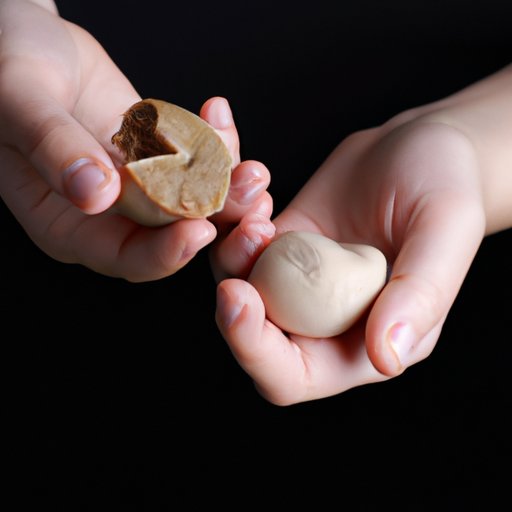
I. Introduction
Gallstones are not a pleasant experience. If you suspect you might have them, act quickly and don’t wait to get help from a doctor. These small, hardened deposits can cause problems in the gallbladder or bile ducts, and lead to a great deal of pain and discomfort. In this article, we’ll take a look at how you can identify the symptoms of gallstones and take the necessary steps to get treated.
II. A Comprehensive Guide to Identifying the Symptoms of Gallstones
Before we dive deeper into the symptoms, let’s start with the basics: what are gallstones and how are they formed?
Gallstones are, quite simply, stones formed in the gallbladder or bile ducts that can cause significant medical problems. The gallbladder is a small, pear-shaped organ in the upper-right side of the abdomen. It stores bile, a fluid made by the liver that helps digest fats. Gallstones are usually made up of hardened cholesterol or bilirubin and can vary in size.
That being said, let’s move on to the most important section of our article: the symptoms.
III. Everything You Need to Know About Recognizing Gallstone Symptoms
Gallstones are a common occurrence in the United States and affect approximately 10-15% of the population. Although anyone can develop gallstones, there are certain groups that are more vulnerable to developing symptoms. These groups include:
- Women
- People over the age of 40
- People who are overweight or obese
- People who have a family history of gallstones or other digestive issues
Gallstones come in different types, and the symptoms associated with each type can vary. The two main types of gallstones are:
- Cholesterol stones: These are usually yellow-green and are made up of cholesterol and other unknown substances.
- Pigment stones: These are usually smaller and darker and are made up of bilirubin and calcium salts.
Both types of gallstones can cause similar symptoms, such as bloating, nausea, or abdominal pain. However, it’s important to know that symptoms don’t always manifest right away. It can take days, weeks, or even months before someone with gallstones starts to experience symptoms
IV. Recognizing the Signs: Understanding Gallstone Symptoms and What They Mean
The most common symptoms associated with gallstones are:
- Intense pain in the upper right part of the abdomen
- Pain in the upper right part of the back
- Pain in the right shoulder
- Bloating
- Nausea and vomiting
- Fever and chills
- Jaundice, a yellowing of the skin or eyes
The pain associated with gallstones can be severe, and the area around the gallbladder may be sensitive or tender to the touch. While pain can be an indication of many ailments, it’s important to be attentive if it’s concentrated in the upper right part of the abdomen for an extended period. Other mild symptoms can be mistaken for a common upset stomach or mild indigestion but can persist even after taking antacids or other over-the-counter medication.
It’s essential to keep an eye out for gallstone symptoms and act urgently when there is severe pain or discomfort. However, many people may have mild symptoms and delay seeking medical attention until their symptoms worsen.
If you’re experiencing any of the symptoms listed above, contact your healthcare provider. They can help you evaluate the severity of your symptoms and determine the course of action needed to treat them effectively.
V. A Closer Look at the Symptoms of Gallstones
In addition to the above symptoms, there are other lesser-known ones that may indicate the presence of gallstones. These include:
- Clay-colored stools or dark urine
- Unexplained weight loss
- Lack of appetite
- Burping
If you’re experiencing any of the symptoms listed above, you should monitor them closely. If they persist, reach out to your healthcare provider for a diagnosis and to explore treatment options.
Preventing gallstones is an important step you can take to avoid experiencing the pain and discomfort associated with them. Lifestyle changes like maintaining a healthy weight, eating a balanced diet, and keeping adequately hydrated can reduce your risk of developing gallstones. However, it’s crucial to know that even following these preventative measures can’t guarantee that gallstones won’t develop.
VI. How to Identify the Warning Signs of Gallstones
It’s important to differentiate between mild symptoms and those that indicate a severe medical issue. Here are a few warning signs that indicate an urgent need to seek medical attention:
- Severe pain in the abdomen or back that lasts more than a few hours
- Yellowing of the skin or eyes
- High fever, nausea, or vomiting
- Light-headedness or dizziness
- Difficulty breathing
If any of these signs manifest, seek medical attention immediately. Reach out to your physician or call 911. Prompt medical attention can prevent complications and help develop a treatment plan to manage the symptoms
VII. Conclusion
Gallstones are a medical issue that can cause severe pain and discomfort. Swiftly identifying the symptoms and receiving prompt medical attention can prevent further complications and ensure a speedy recovery.
Remember to maintain a healthy lifestyle to reduce your risk of developing gallstones, and if you’re experiencing any abdominal pain or symptoms lasting longer than a few hours, reach out to your healthcare provider.
Proactively seeking treatment can lead to a faster recovery and produce a better quality of life. Small steps taken today can reduce the risk of future health complications.





